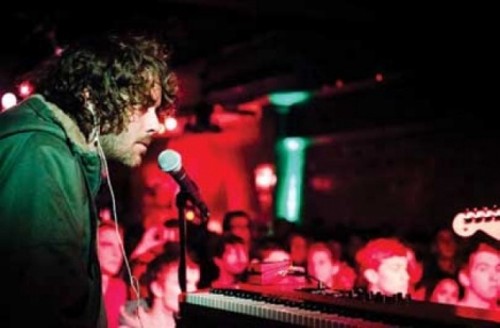In Velour’s lobby and on the sidewalk, where 100 or more folks are lined up for The Moth & The Flame’s 11/11/11 CD release show, there are sculptures of giants: Art meets art rock. There’s a giddy excitement, like winged creatures of the night attracted to a terrestrial light.
You wouldn’t know it backstage, though; there are mild laughs about infamous Provo emcees and ridiculous banter about blowing oneself up in a rock & roll blaze of glory. The air is calm. If there is any anxiety, it is hidden under the gummy bears and assorted candies that lie on the table. Below LP covers of quintessential rock and folk greats pinned to the walls of the dimly lit green room, a veritable who’s who of the scene’s musicians pop in to offer support.
Perhaps the calm is from comfort. Brandon Robbins, the band’s guitarist and vocalist, is no stranger to the Velour stage. “I started as an official nobody here—playing open-mic nights with horrible gear,” he recalls. He’s circled up with his band on an array of thrift-store couches.
“As a sound guy, you totally judge bands based on their gear, and I was like, ‘Oh, great,’” says Nate Pyfer, who runs sound for Velour’s Tuesday open-mic night on occasion; he is now a member of The Moth & The Flame and the producer of their self-titled debut.
“While I couldn’t understand a single lyric Brandon sang, there were just these unbelievable melodies,” Pyfer says. “They were not four-chord songs.” That night, Robbins was joined by keyboardist Mark Garbett for their first public performance. Pyfer remembers thinking that they just needed direction. Robbins and Garbett cite Pyfer and Velour owner Corey Fox as helping define that direction. The outcome: ambient-rich, lush tunes that speak for themselves—nine songs that oscillate from dark and brooding to synthy, Radiohead-esque gems.
On the stage, there is upgraded gear for Robbins and Garbett and an array of sample pads to trigger special effects. “We like using that stuff so we can be more true to the record,” Pyfer says. “I want to go to a show and not hear a thin version of a band’s songs.” There’s no “press play” moment on a laptop. It is honest and true. This is the first time many people will hear these songs.
That same calm from backstage was mirrored as the band played. If someone was chatting, they were soon hushed—a harmonious hush. It was a collective, nonverbal contract toward reverence and curiosity. The show highlights were also the finer points of the album—a song like “Home,” or even moments like the bridge in “&.”
The band seemed to soak up the silence and use it as a canvas for their intricately crafted tunes that evening. Their paintbrushes are influenced by some greats: “Musically, the professionalism of Radiohead; artistically, Beck—everything he does,” Robbins says.
The songs were unraveled in the same order as the album. “These nine songs are so different, but they fit together so well as an artistic project. The production and the feeling of it is what connects the whole album,” Robbins says in response to Garbett discussing a video series.
“We want to do a video series—one for almost every song on the album. I have a lot of ideas, but it’s hard to explain,” Garbett says. “Maybe when we get more videos out, it will make sense. It will be simplistic, but with a heavy focus on the visual.”
This artistic aesthetic is pivotal for what The Moth & The Flame hope to be. The first video, “Goodbye,” will include those giants from out front and the band dressed up as turn-of-the-century pilots/adventurers; the video will premiere early 2012, Garbett says. “We’ve based the video off of the album artwork, and when we saw [the artwork], we knew that we had to have it. The textures, the meaning, the symbolism—it really connects to our sound,” Robbins says. The album is not currently available for digital download because the artwork—a surreal image of a turn-of-the- century pilot propped up horizontally by crutches in an expansive, bleak desert—is so important to the release, according to the band’s Website, HowWeWokeUp.com.
With all of these art-rock sentiments, the band is cautious in what they communicate. “I do realize the mantle of influence. Whatever we write, we want to make sure it’s positive,” Robbins says, acknowledging that most people would think the album is filled with sad songs, but the listener comes away with a feeling of hope, of motivation. “We want to make sure we’re not writing the next Katy Perry song. We’re not promoting a bunch of teen sex. Well, we’re not teenagers, otherwise we would be,” Robbins says with a laugh.
More by Austen Diamond
-
Wasted Space
342 S. State, Salt Lake City
- May 6, 2015
-
Jackalope Lounge
372 S. State, Salt Lake City
- Apr 22, 2015
-
Geeks Who Drink at Piper Down Pub
1492 S. State, Salt Lake City
- Apr 15, 2015
- More »
Latest in Music
Readers also liked…
-
The Alpines Head North
Local band's debut concept album finds musical bliss in the apocalypse.
- Feb 7, 2024



